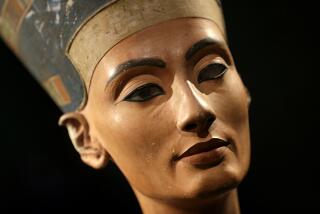The New, Improved Mehndi
- Share via
It was only a matter of time. After catching on among contemporary trend followers, the centuries-old art of mehndi--painting on the skin in intricate henna-colored designs--is getting a new look. Sacred Earth, a downtown Los Angeles mehndi boutique, decided that enough dull reddish brown was enough and has created dyes that are painted on in the ancient designs, only in bold, multicolored shades.
Another innovation, says Sacred Earth’s executive officer Nadine Damas, is that instead of the messy traditional liquids and powders that require mixing, these dyes come in a long-nosed tube, ready to swirl on like cake icing. So far, the palette is limited to eight colors: green, red, turquoise, magenta, blue, purple, black and white. But “just about any color is possible,” Damas says. Costs vary. The price for designs on both hands, depending on the complexity of the design, varies from $20 to $60.
For the uninitiated, mehndi is said to have originated in Africa and made its way to India. Part of its appeal, besides that it is painless, is that this tattooed look wears off in about six weeks. (Sacred Earth’s colored designs wear off in two to three weeks.)
Parties are current hot spots for mehndi artists to ply their trade, and the 12 or so artists who work for Sacred Earth have been to their share. They have worked at corporate events and parties, including the premiere for “Scream 2” and attorney Robert Shapiro’s daughter’s bat mitzvah.
Requests for other styles of body painting may be fulfilled as well, and with respect. A recent Hollywood client wanted dog paws painted across her chest in black.
“But often what we think is weird is quite normal to other people,” Damas says. “We learn not to judge.”
A competitive business, the mehndi world cranked up when such celebrities as Demi Moore, Mira Sorvino and Erykah Badu started wandering through magazines with the intricate, ancient designs. A number of such layouts were done by Sacred Earth’s artists, Damas says. The company did Sorvino in “The Replacement Killers” and Badu for a layout in Essence magazine.
It takes some ingenuity--and guts--to change an art form after several thousand years, but Damas is mum on the nascent process.
“If we told the secret,” she says, “every other company would jump right in and copy us.”






